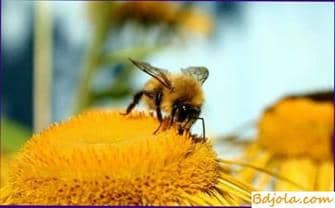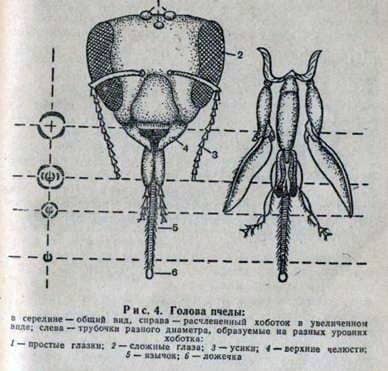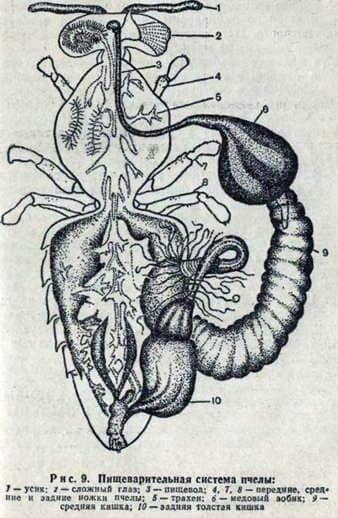Functions of the proboscis and honey beetles of the bee

To collect and bring nectar to the hive of bees, as well as in other insects (Hymenoptera), feeding on nectar, in the course of evolution have developed very sophisticated organs: proboscis licking-sucking type that bees collect even tiny droplets of nectar and honey zobik – tank collecting nectar and bringing it to the hive.
Proboscis.
Around the mouth bees is six mouthparts upper lip – plate covering the mouth of the upper pair of powerful jaws (mandibles) arranged as mites, bee which captures solid particles or chew; the remaining three oral appendages-the lower lip and the two lower jaws-form a proboscis.

Lower lip-the main part of the proboscis-begins with a small triangular joint (chin base) attached to the suspender unit connecting it to the head (see Figure 4). It is followed by an elongated, thick segment – chin, from which a long, almost circular tongue ends, ending with a spoon. In the place of attachment of the tongue to the chin go two tentacles of the lower lip. The long tongue consists of a set of strong rings, connected by a soft skin, providing its flexibility and mobility. The tongue has hairs directed toward its outer end.
The two lower jaws are located on the sides of the lower lip. This elongated, slightly curved formations, consisting of two segments – the main and outer lobe of the lower jaw. The combined lower lip and lower jaws form channels of different diameters to suck in liquid food.
The smallest capillary canal is in the tongue; it serves to advance the secretion of glands to the end of the tongue. The bee released by the liquid can, for example, dissolve a grain of sugar, which without it would remain unused.
The medium-diameter channel serves to suck nectar when licking it with a spoon. It is formed when the channel is straightened in an elongated
For the collection of nectar from the flowers of plants, the length of the proboscis is important, which allows you to reach the nectar, allocated on the bottom of flowers with a long and narrow tube. The greatest length (6,9-7,2 mm) of the proboscis has bees of gray mountain Caucasian breed. These bees can collect nectar from flowers of meadow clover. Central Russian bees have proboscis lengths of 5.4-5.9 mm; they collect nectar from meadow clover only when a lot of nectar accumulates in the flower and its level rises substantially, or when plants are poorly developed due to weather conditions and give flowers with shortened (underdeveloped) coronets.
Honey comb.
From the pharynx leaves a long narrow esophagus, which runs through the entire chest, and at the beginning of the abdomen, greatly expanding, forms honey cindian.

The wall of honey crocus has numerous folds, which allows to greatly increase the volume of crab when filling with nectar. The volume of honey cowberries in a calm bee in a hive does not exceed 14 mm3, but when filled with nectar or honey, it can increase 3-4 times. Honey crab serves as a reservoir in which it collects nectar, and also transfers honey to the hive. The muscles located in the wall of the crab, cutting, squeeze the liquid out through the esophagus and proboscis.
Honey zobik plays a big role in regulating the amount of sugar in the hemolymph.
Sugar, mainly glucose, is always contained in the bee’s hemolymph and serves as an energy material directly used for the work of muscles and for the formation of heat. The more vigorous and quicker the muscles contract, the more hemolymph the sugar contains. During flight in the hemolymph, the bee contains 2-4% of sugar. If the sugar concentration drops below 1%, the bee is unable to fly, and when it is below 0.5% it becomes immobile.
With an empty honey beet, the bee can fly about 15 minutes due to the carbohydrates of the hemolymph. However, when the honey is filled with honey, the activity of the bee is quickly restored. Consequently, in a bee honey beetle serves as a regulator of sugar content in the hemolymph.
Dwarf glucose in hemolymph is less than that of worker bees, and its quantity is quite constant (1.2%). In the uterus, a high sugar content is observed only in the first days of its flights to mating. With its transition to egg laying, the sugar content decreases and is maintained at the same level (1.0%) regardless of its age. When preparing for swarming, the concentration of sugar in the hemolymph of the uterus rises again.
Behind honey beetles, the bee has the Middle intestine , the main center of digestion, decomposing I sucking all the components of the bee’s food. The honey croup is connected to the midgut by a small intermediate gut that regulates the feeding of the food (nectar, pollen) to the middle intestine, and also cleans the nectar from excessive pollen.
Bees, because of their families, have very great possibilities for regulating their food: under certain conditions they consume oxygen and fodder very economically, while in others they develop very fast energy. So, the Russian explorer-zoologist V. V. Alpatov showed that a quietly sitting bee consumes 8 mm3 of oxygen per 1 minute, the bee moves 36 mm3 at the same conditions, the bee is excited – 520 mm3 per 1 min. In bees, the ratio of the minimum physical stress to the maximum is 1: 140, while in humans it is equal to 1:10. Such a huge plasticity of metabolism leads to the same consumption of honey: in some conditions the bees consume very little honey, while in others, when they are worried, much more.
Functions of the proboscis and honey beetles of the bee
